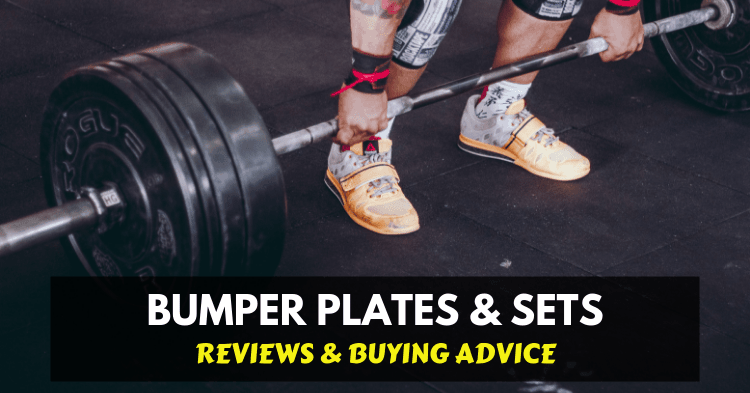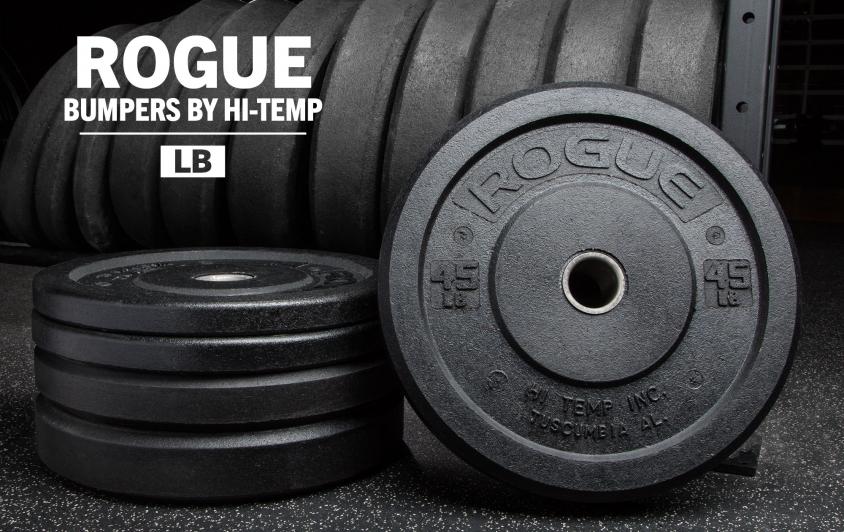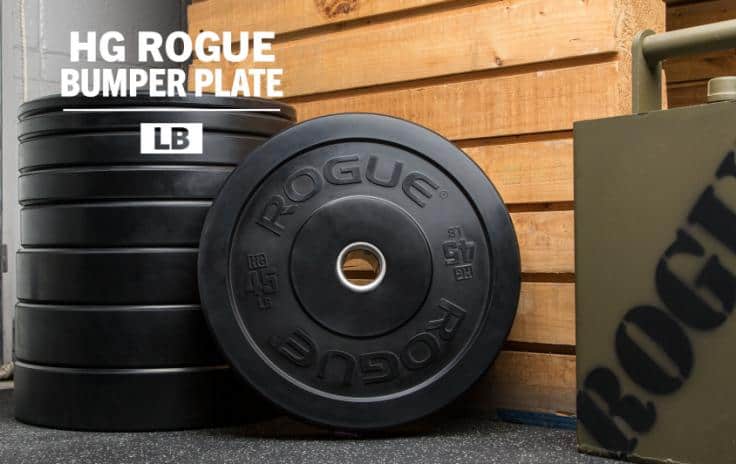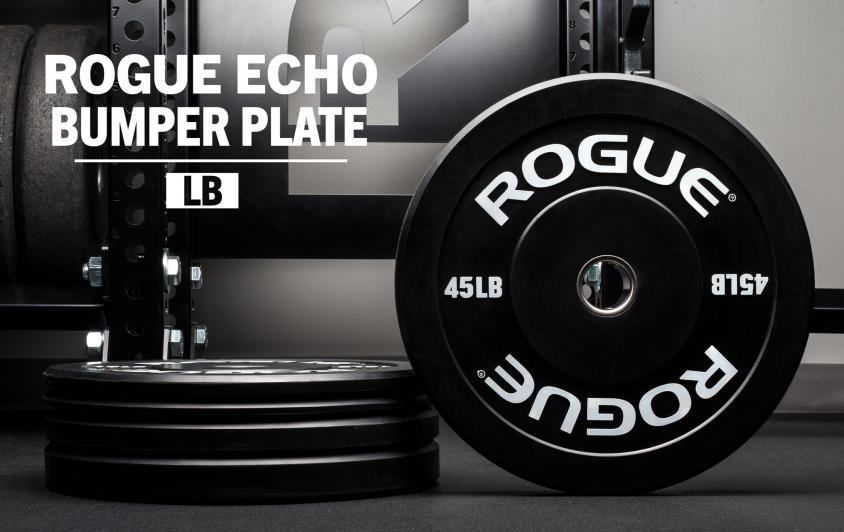
Bumper plates are one of the biggest spends for any home gym. They’re going to cost a significant amount of money, so you need to really think about what you’re getting and make sure that whatever you buy is well-suited to what you want from it.
Today we’re going to take you through a number of popular bumper plates on the market and outline what you should look out for when buying!
Contents
- Find Your Favorite Bumper Plates
- 1. Rep Fitness Bumper Plates
- 2. Rogue Hi-Temp 1.0 Bumper Plates
- 3. Rogue Hi-Temp 2.0 Bumpers
- 4. Rogue Echo Bumper Plates
- 5. Fringe Sport Bumper Plates
- 6. Xmark Hi-Impact Bumper Plates
- 7. Titan Fitness Bumper Plates
- 8. HulkFit Coloured Bumper Plates
- 9. X Training Black Bumper Plates
- 10. CAP Barbell Bumper Plates
- Why Use Bumper Plates?
- Bumper Plate Buying Advice
- Our Pick and Final Thoughts
Find Your Favorite Bumper Plates
1. Rep Fitness Bumper Plates

These plates are a good example of the minimums you should hold for a bumper plate. They’re not perfect, high-quality products like a Werk San or Eleiko bumper, but they’re solid and they have a clean design that looks great.
The thickness of plates is a significant benefit here, with even the 45lbs plates being a decent width at 2.8” thickness.
Obviously, the fact that these are in lbs is a real pain. The standard weight measurements for Olympic weightlifting plates is kilos (all over the world, even in America), so lbs plates without a kg option is annoying.
Problems with these products tend to be in a chemical smell (common with plastics/rubbers) and some issues with delivery/rough packaging. These are pretty standard issues and don’t seem to affect the integrity of the plates themselves.
- Decent design
- Good finish and density
- Decent durability
- No Kilogram plate option
- The product tends to have a standard, unpleasant petrochemical smell
- The packaging is often damaged, indicating poor delivery quality
2. Rogue Hi-Temp 1.0 Bumper Plates

We’ve worked with these Rogue plates in the past and there’s a lot to be said for them as a basic minimum quality of bumper plate. If your plates aren’t this good, then you should probably be concerned.
The Hi-temp bumpers are an annoying product to use when compared to a high-quality bumper plate due to the lower density construction, very thick design, and the fact that the material is relatively low quality.
They’re not going to run into significant problems with durability, but it’s important to remember that the lifetime of this product should be decades. Having used the 1.0 hi-temp bumpers, we can say they’re definitely a decent product, but they’re on the borderline!
- Cheap
- Bouncy and comfortable with harder surfaces
- Very thick
- Low-density material
- Durability is relatively low compared to better quality plates
3. Rogue Hi-Temp 2.0 Bumpers

These are everything that the original hi-temp bumpers should have been.
The design and manufacture of these products – all the way down to the material choices – are so much better. There’s a reason the 2.0 is designed to replace the old hi-temp when it comes to design! They’re better in every way!
The finish is a much higher quality and more hard-wearing, resembling a classic training bumper plate rather than a cheap knock-off. The thickness of these plates is still a concern as they’re nearly ½ an inch thicker than the Rep Fitness products on a like-for-like basis.
These are harder than the original hi-temp, too, which means better feedback and less “Rogue” bar-bouncing.
(That’s our pun and we’re sticking with it.)
- Fat better than the original hi-temp bumpers
- Better material choices and density
- Classic finish, with tough outer
- Still a thick plate
- Good but not amazing material/build
4. Rogue Echo Bumper Plates

The Echo bumpers are a step up from the Hi-temp 2.0. The jump in quality is similar to that from the 1.0 to 2.0, meaning that this bumper is the kind of equipment you would get at a high-quality home gym.
The thickness problems have been addressed, the design is clean and pretty, and the whole set is designed to international weightlifting federation standards. These are some of the best quality Rogue bumpers for a home gym, combining economy with attention to detail.
Again, these aren’t the most premium products around, but they strike a great balance between quality and price. Heavier plates are also warrantied for 3 years, which is really cool, and there are kg/lb alternatives (as with all rogue plates).
- Best quality rogue plates so far
- Good design and thickness
- Great material choices and outer-finish
- Clean, enjoyable design for a black plate
- There aren’t any real cons to this product
- It’s not a metal-ring design, if we’re being picky!
5. Fringe Sport Bumper Plates

The Fringe Sport bumpers carry a similar design to the Rogue echo plates with a denser construction and finish than others we’ve discussed so far. As with the Rogue plates, they come with a slick design and an effective, slightly slimmer construction than some competitors.
Fringe Sport actually have a good reputation for economy plates and have seen good commercial use. The design is a polished, clean one and they definitely strike a good balance between economy and function/durability.
The only problems seen with this product relate to the inner steel circle that should allow them to slide onto/off the bar. This is a concern for those with low-quality barbells, which may not be perfectly IWF-regulation size and design.
There should be some allowance built into a regular plate, but the Fringe Sport plates tend to run a little small. This is a concern but is a rare occurrence for most and is addressed with small amounts of lubricant (and good quality clips!).
- Good design with coloured lettering and a clean finish
- Good material choices and thickness provide durability and usability
- Great compromise between price and quality
- Can be a little on the smaller side, which may provide problems for hybrid/fitness barbells, though this can be addressed
6. Xmark Hi-Impact Bumper Plates

These are also thick plates, which makes them less appropriate for a home gym since you’re going to get stronger. For an average sized man, the thickness of these plates can rapidly become an issue!
If you’re shorter/smaller or a female, you’re likely to get a lot more use from these plates. The actual construction and finish seem fine, with a 3-year warranty to ensure you’re not running into immediate problems with your products.
As with other products, there are some concerns for grease and smells. These continue to be a persistent issue with bumper plate, generally, however. The density of these plates has been discussed by some customers, but they’re really not a problem. Bumpers are meant to bounce, but density is important for durability and quality.
These are a decent product, on par with Rep Fitness, but not outstanding.
- Decent design and material
- Durable with a good finish
- Far too thick
- Density is not perfect; some complain it’s too hard
7. Titan Fitness Bumper Plates

As with other products, the Titan bumper plates are too thick for our liking. The use of 3.5” 45lbs plates is a real problem. These are some of the thickest plates with such a low weight, making them a pain to use.
There’s not much chance of getting significant weight on a standard barbell with the titan plates! On top of this, Titan fitness has established something of a reputation for being a sub-optimal manufacturer.
Overall, we’re unimpressed with these plates and would put them at the same level as the Rogue hi-temp 1.0: there are better products you could go for!
- Nothing stand-out
- Titan’s reputation for providing equipment isn’t great
- Unbelievably thick, no use for heavy lifting
- Upper limit is a 45lbs plate, which is not a full range
8. HulkFit Coloured Bumper Plates

This is the first upper-quality product we’ve discussed on this list. This takes the standard construction and design of economy plates (like the Rogue hi-temp 2.0 and echo) and starts to look more like competition plates.
The inner steel ring of the HulkFit plates is a great piece of design and improves long-term durability. The plate is held together, effectively, rather than being a ring of rubber on a smaller ring of steel.
The design of these plates is clean and pretty, but crucially they’re hard-wearing and within standard regulation sizes. The width is slightly more than we’d want for a top-quality bumper plate, but the overall product is decent.
The only concern here is that you won’t see significant functional benefits over the Rogue Echo, but if you like color-coded plates then this is an okay choice.
- Great design with color-coding
- Steel Rim allows for better durability and force absorption
- A little more expensive
- No amazing, beyond the improved appearance
9. X Training Black Bumper Plates

This product line has some serious quality assurance problems. The 2” internal hole is often not correctly sized, making them entirely useless, while other examples of problems include plates utterly shattering with regular use within warranty periods.
This product also manages to out-do other common bumper plates for the absolutely unholy stench they carry. While there’s a standard expectation of plastic processing smells in bumper plates, the consistency and severity of customers reporting this product’s smell is a new level!
Overall, we’re suggesting you give this product a miss!
- We really can’t figure out what the pros of this product are
- Poorly quality-assured
- Many examples of useless, poorly-designed internal holes
- Plates may shatter with regular, intended use
- The worst petrochemical smell that we have heard of on the market
10. CAP Barbell Bumper Plates

CAP barbell has a distinct history of being “okay”. This is the extent of their reputation on the market. This product continues this 30-year history by being a mixed bag of good and bad.
The good is that they seem to work for their intended purpose in most cases. This means that they bounce, they’re made of decent material, and they’re not breaking all the time. As one customer has said it does “exactly what it says on the tin”.
The bad is that, as an economy plate, there’s a significant concern for the occasional plate splintering and cracking from the middle. This is a result of the steel ring being small and the plate construction being made of slightly rigid, lower-durability rubber than a premium plate.
Overall, decent, but not amazing!
- Good basic design
- Effective material choices
- An economy plate with decent market-competitive pricing
- Plates may splinter around the metal ring rather easily
- Plate construction seems to be lower-durability than some products on this list like the Rogue Echo
- CAP Barbell’s “reputation for innovation” doesn’t exist, rather their reputation is normality and mediocrity
Why Use Bumper Plates?
Bumper plates are rubberized weight plates that allow you to drop a barbell without worrying about breaking brittle cast-iron plates or your floor!
These plates are most convenient for a home gym since you’re going to want to reduce the impact on your floors. However, they also allow you to perform a number of Olympic weightlifting movements and power-training movements with a barbell that you couldn’t otherwise.
Performing power cleans with iron plates, for example, is an absolute nightmare. Equally, performing maximal effort push presses and other overhead movements is just asking for problems if you’re not using bumper plates.
Bumper Plate Buying Advice
Pound vs Kilo Plates
Kilogram plates are the better plates. This is a simple fact of the construction and use of bumper plates: all the powerlifting and Olympic weightlifting applications make more sense in kilograms, so a manufacturer that doesn’t offer kilogram plates is a problem.
If you like lifting in lbs that’s totally fine, but the intended purpose of bumper plates is to make Olympic lifting possible. Every country in the world – even the US – uses kilogram plates for weightlifting. The option to choose between the two is great, but if there are no kg plates then we’re concerned.
Many of the options on this list come with lbs and kg plate options, but where we can’t find customer choice, we’re concerned!
Basic Training Plates vs. Competition Plates
You don’t need competition plates at home. They’re called competition plates for a reason!
They’re very expensive but the functional benefits are absolutely zero. If you have a million dollars lying around, competition plates are beautiful and a great treat to yourself.
However, when it comes to what they actually do for your training on a day to day basis, the answer is nothing. It also goes without saying that you shouldn’t buy a competition barbell-plates set, since a competition barbell is going to shred your hands/neck/shoulders.
How Much Weight Do You Need?
This is really a question of what you’re going to be doing with your barbell/bumper plates, how strong you are now, and how long they’re going to last.
We recommend starting with slightly more weight than you need now, since you can always add more. If you’re looking to build out a home gym, it makes more sense to add more weight to your collection over time, rather than dropping thousands on 400kg of plates you’ll never lift.
The best solution is to buy the amount of weights you’ll need in a year from now, if you progress consistently. This is going to make sure you have a surplus, without over-buying in an extreme way and wasting money on plates that you have no hope of lifting this decade!
For a total beginner, a set of 20kg plates, 15kg plates, 10kg plates and 5kg plates are probably enough. Then you need a set of 2.5/1.25kg plates to allow you to overload effectively. You can buy a pair of 25kg plates later on.
If you’re really not sure, go to a gym for a few weeks and get an idea of what you can move. You need a good idea of what you can do to plan out what you need to buy!
Inner Ring Diameter: Does It Fit the Bar?
Bumper plates should always be Olympic standard, which means a 2” hole to fit an Olympic barbell. Bumper plates that do not have this specification are missing the point and not worth your money.
However, within this range there’s variability and some products are better than others. A bumper plate’s central construction – specifically how snugly it fits a barbell and how well-built the ring is – make a product better or worse.
You want a product that does not slide on the cuffs of an Olympic barbell. It has to fit, but it should remain in place within reasonable allowances on a good barbell. It’s easy to get slippery, poorly-fitted plates are annoying and less-safe to work with!
Durability
Bumper plates are literally made to be dropped from overhead. They need to be built to lat with a hard-wearing material and finish.
A poor quality build or material choice for a bumper plate will make the difference between high-quality and low-quality. This will mean replacing plates, which shouldn’t really be a concern: the best quality bumper plates last for decades. We still train on Eleiko bumper plates from the 1970-80s!
Any product that doesn’t have a high-durability construction is a waste of your time unless you really need to save money. If you’re willing to deal with replacing bumper plates every few years, a budget option is okay, but a good plate is a lifetime investment!
Material
The material and the composition of the bumper plates makes a huge difference. This affects everything from durability to actual performance, thickness, how they bounce, and the price.
Lower-density rubbers are a common material for lower-quality plates that provide a thicker plate with worse durability, but at a lower cost.
On the other hand, the best plates are made from a high-density rubber or plastic, with a steel insert to keep weight calibrated and consistent. You can tell the difference in these plates quite easily, and they do make a difference to the overall feel and quality of the product.
A steel-insert plate with a rubberized inner and hard-finish is one of the best possible builds, and offers amazing durability, bounce, but at a higher cost.
There are many options in the middle of these two extremes, but the quality and materials/build you need will depend on the cash you have to spend, and how serious you are about barbell training.
Thickness
Thinner bumper plates tend to be better, and you can fit more of them on the barbell. Lower-quality, low-density rubber plates without metal inserts trade off their cheap price tag for real logistical problems putting weights on barbells.
For example, you’re likely to max out a standard 7-8’ Olympic barbell at around 170-200kg of these plates. This really isn’t much when you consider that an average man should be squatting/deadlifting more than this within the lifetime of a set of bumper plates.
Thinner bumpers are either made of a higher density material or contain steel plates for weight. They cost more, obviously, but at some point, you’re going to run into the best problem: being too damn strong for the space on your barbell!
Design: Color Coded vs. Black
Color-coded Olympic plates are more expensive due to the increased expense in producing them. However, they also provide clarity on what you’re lifting and they’re closer to the competition style plates used in Olympic weightlifting.
There’s really no benefit to having color-coded plates, but they are prettier and it’s clear what you’re lifting at all times. If you want a sexy home gym, color-coded plates are great but absolutely not essential – they do not provide any functional benefits.
Bounce
Speaking of things that don’t have any functional benefits, we’re often asked how much bounce a bumper plate should have.
The reality is it doesn’t matter. There’s no significant differences between the bounce of two sets of bumper plates, unless you’re specifically looking for a softer landing for your floors. The problem is that, while lower density doesn’t damage your floor, it’s more likely to fall apart.
You should be dropping bumper plates on a shock-absorbing surface. If you’re doing this bit right, it doesn’t matter how much bounce there is to your bumpers. Just control the weight as you return it to the floor, rather than slamming it down.
Price
Saving money is good and bumper plates are very expensive per lb. they are one of the biggest expenditures, and you’re going to want to save money where you can. However, there’s no point buying bunk that isn’t going to suit your goals.
Getting a good price is key, if all other things are equal. However, it’s only one factor in a whole collection of factors that determine which product is best-suited to your needs.
Should You Buy Used Bumper Plates?
Used bumper plates are great if you can find ones that meet your goals/needs. As before, it’s easy to get low-quality bumper plates that aren’t durable or well-made. Given the price, it’s sensible to save money with second-hand, used bumper plates.
You need to check used bumper plates against the exact same criteria that you would with new plates. There’s a good chance they’re perfect for your needs, since bumper plates don’t degrade easily, and any problems should be visible from the offset. If it looks good and feels good, it’s probably good!
Our Pick and Final Thoughts
Getting good bumper plates can make or break your experience. They’re not as important as getting the right barbell, but they do play a significant part in your day to day training.
Getting the right set of bumper plates is just a matter of figuring out how much you need from them, and how much you can afford to invest in them. The better plates, the less likely you are to need to replace them, so it’s a fine balance!
The clear winner of this piece is the Rogue Echo bumper plate. While there are better plates, this product establishes itself as a reliable and well-guaranteed product with a perfect balance of economy and quality. Rogue’s reputation is good, and these products are also exactly that: good, but at a great price.
If you’re looking to get great weight training at home, bumper plates are a great choice, and these are the products that make this easier in your own home!